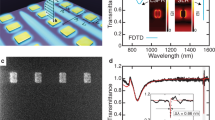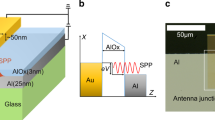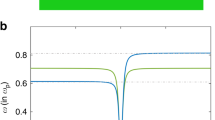Abstract
Metamaterials are artificial materials with subwavelength structure1 that enable the translation of magnetic2 and electric responses3 into spectral regions not accessible through naturally occurring materials. Here, we report direct measurements of the propagation and confinement of terahertz electromagnetic surface modes tightly bound to flat plasmonic metamaterials that consist of metal surfaces decorated with two-dimensional arrays of subwavelength-periodicity pits. These modes are surface plasmon polaritons with an effective plasma frequency controlled entirely by the surface geometry4. The mode spectrum and penetration depth into air demonstrate strong wavelength-scale energy confinement to the surface below the electromagnetic band edge; this is in stark contrast to the very weak confinement found at flat metal surfaces in this spectral regime. The results are in good agreement with analytical and numerical models of surface plasmon polaritons propagating on structured perfect-conductor surfaces, and imply that plasmonic metamaterials could help miniaturize optical components or lead to improved chemical or biochemical sensors.
This is a preview of subscription content, access via your institution
Access options
Subscribe to this journal
Receive 12 print issues and online access
$209.00 per year
only $17.42 per issue
Buy this article
- Purchase on Springer Link
- Instant access to full article PDF
Prices may be subject to local taxes which are calculated during checkout





Similar content being viewed by others
References
Smith, D. R., Pendry, J. B. & Wiltshire, M. C. K. Metamaterials and negative refractive index. Science 305, 788–792 (2004).
Pendry, J. B., Holden, A. J., Robbins, D. J. & Stewart, W. J. Magnetism from conductors and enhanced nonlinear phenomena. IEEE Trans. Microwave Theory Tech. 47, 2075–2084 (1999).
Pendry, J. B., Holden, A. J., Stewart, W. J. & Youngs, I. Extremely low frequency plasmons in metallic meso structures. Phys. Rev. Lett. 76, 4773–4776 (1996).
Pendry, J. B., Martin-Moreno, L. & Garcia-Vidal, F. J. Mimicking surface plasmons with structured surfaces. Science 305, 847–848 (2004).
Shah, J. Ultrafast Spectroscopy of Semiconductors and Semiconductor Nanostructures (Springer, New York, 1996).
Ferguson, B. & Zhang, X.-C. Materials for THz science and technology. Nature Mater. 1, 26–33 (2002).
Strachan, C. J. et al. Using terahertz pulsed spectroscopy to quantify pharmaceutical polymorphism and crystallinity. J. Pharm. Sci. 94, 837–846 (2005).
Nagel, M. et al. Integrated THz technology for label-free genetic diagnostics. Appl. Phys. Lett. 80, 154–156 (2002).
Yamamoto, K. et al. Noninvasive inspection of C-4 explosive in mails by terahertz time-domain spectroscopy. Jpn J. Appl. Phys. 43, L414–L417 (2004).
Zhang, J. & Grischkowsky, D. Waveguide terahertz time-domain spectroscopy of nanometer water layers. Opt. Lett. 29, 1617–1619 (2004).
Kurt, H. & Citrin, D. S. Coupled-resonator optical waveguides for biochemical sensing of nanoliter volumes of analyte in the terahertz region. Appl. Phys. Lett. 87, 24119–241121 (2005).
Maier, S. A. Plasmonics—Fundamentals and Applications (Springer, New York, 2007).
O'Neal, D. P., Hirsch, L. R., Halas, N. J., Payne, J. D. & West, J. L. Photothermal tumor ablation in mice using near infrared absorbing nanoshells. Cancer Lett. 209, 171–176 (2004).
Barnes, W. L., Dereux, A. & Ebbesen, T. W. Surface plasmon subwavelength optics. Nature 424, 824–830 (2003).
Ozbay, E. Plasmonics: Merging photonics and electronics at nanoscale dimensions. Science 311, 189–193 (2006).
Saxler, J. et al. Time-domain measurements of surface plasmon polaritons in the terahertz frequency range. Phys. Rev. B 69, 155427 (2004).
Wang, K. & Mittleman, D. M. Metal wires for terahertz waveguiding. Nature 432, 376–379 (2004).
Jeon, T.-I. & Grischkowsky, D. THz Zenneck surface wave propagation on a metal sheet. Appl. Phys. Lett. 88, 061113 (2006).
Gómez-Rivas, J., Kuttge, M., Haring Bolivar, P., Kurz, H. & Sánchez-Gil, J. A. Propagation of surface plasmon polaritons on semiconductor gratings. Phys. Rev. Lett. 93, 256804 (2004).
Goubau, G. Surface waves and their application to transmission lines. J. Appl. Phys. 21, 1119–1128 (1950).
Mills, D. L. & Maradudin, A. A. Surface corrugation and surface-polariton binding in the infrared frequency range. Phys. Rev. B 39, 1569–1574 (1989).
Ulrich, R. & Tacke, M. Submillimeter waveguiding on periodic metal structure. Appl. Phys. Lett. 22, 251–253 (1973).
Hibbins, A. P., Evans, B. R. & Sambles, J. R. Experimental verification of designer surface plasmons. Science 308, 670–672 (2005).
Garcia-Vidal, F. J., Martin-Moreno, L. & Pendry, J. B. Surfaces with holes in them: New plasmonic metamaterials. J. Opt. A 7, S97–S101 (2005).
Maier, S. A. & Andrews, S. R. Terahertz pulse propagation using plasmon-polariton-like surface modes on structured conductive surfaces. Appl. Phys. Lett. 88, 251120 (2006).
Jepsen, P. U., Jacobsen, R. H. & Keiding, S. R. Generation and detection of terahertz pulses from biased semiconductor antennas. J. Opt. Soc. Am. B 13, 2424–2436 (1996).
Andrews, S. R., Armitage, A., Huggard, P. G. & Hussain, A. Optimization of photoconducting receivers for THz spectroscopy. Phys. Med. Biol. 47, 3705–3710 (2002).
Zhizhin, G. N., Moskalova, M. A., Shomina, E. V. & Yakovlev, V. A. Surface Polaritons: Electromagnetic Waves at Surfaces and Interfaces (eds Agranovich, V. M. & Mills, D. L. ) (North Holland, Amsterdam, 1982).
Acknowledgements
This work was supported by the Air Force Office of Scientific Research (AFOSR) (FA9550-05-1-0488) and the Royal Society. Financial support from the Spanish Ministerio de Educación y Ciencia (MEC) under contract MAT2005-06608-C02 and from the EU under project FP6-2002-IST-1-507879 (Plasmo-Nano-Devices) is also gratefully acknowledged.
Author information
Authors and Affiliations
Corresponding authors
Rights and permissions
About this article
Cite this article
Williams, C., Andrews, S., Maier, S. et al. Highly confined guiding of terahertz surface plasmon polaritons on structured metal surfaces. Nature Photon 2, 175–179 (2008). https://doi.org/10.1038/nphoton.2007.301
Received:
Accepted:
Published:
Issue Date:
DOI: https://doi.org/10.1038/nphoton.2007.301
This article is cited by
-
Demonstration of a terahertz coplanar-strip spoof-surface-plasmon-polariton low-pass filter
Scientific Reports (2024)
-
Dispersion curve engineering for automated topology design of a unit cell in spoof surface plasmon polaritons
Scientific Reports (2024)
-
Highly Confined Terahertz Surface Plasmons Generation in Graphene-Coated Optical Fiber by Nonlinear Mixing of Two Laser Beams
Plasmonics (2024)
-
Design of terahertz plasmonic wavelength division multiplexer assisted by whispering gallery mode resonators
Optical and Quantum Electronics (2023)
-
Light Plasmon Coupling in Planar Chiroplasma–Graphene Waveguides
Plasmonics (2023)



